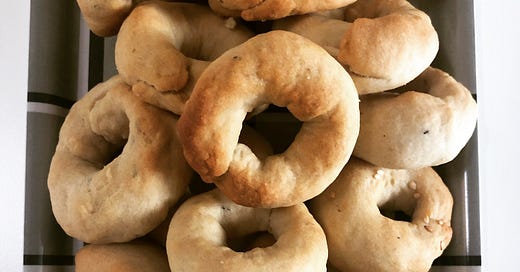Some biscuits announce themselves with grandeur—stuffed with jam (especially this time of year, for Purim celebrators), dusted in sugar, dripping with honey.
Kaka is not one of those biscuits.
It’s subtle. It’s sturdy. It’s savory. It’s dangerously snackable.
A staple of Baghdadi Jewish kitchens, kaka is the kind of biscuit that sneaks into your daily routine—until one day, you find yourself reaching for it every time you make tea, completely unaware of the addiction forming in real-time. You bake a tin, thinking it will last the week. It lasts two days, max.
What’s in a Name? A Biscuit by Any Other Name Would Still Disappear Just as Fast
Yes, we could rebrand it.
We could call them tarallini.
But we won’t.
(Plus, kakas are tastier.)
And this, of course, raises the moral dilemma—why the hell didn’t they just spell it “Kahka” and avoid all embarrassment?
But who am I to argue?
(And don’t laugh too hard—especially if you remember that famous Brazilian footballer.)
Kaka is a word with deep roots. The Norse word "kaka" is the ancestor of cake (English) and Keks (German). But our Baghdadi kaka comes from a different lineage—one that winds through the Middle East and the Sephardi world.
In Israel, these biscuits are often called Abadi, after the Jerusalem family that still makes them today. Those are firm, dry, and packed with sesame—great for dipping.
But our version?
It’s softer, crumblier, a tea-time staple rather than a dunking biscuit.
And if you’re thinking, wait, this sounds familiar, you’re not wrong. Kaka shares DNA with Italy’s tarallini—those fennel-flavored rings of crisp dough that pair perfectly with wine. Swap out the caraway for rosemary, and suddenly, you’re one ingredient away from Southern Italy.
A Classic Recipe with a Modern Twist
After reviewing six different family recipes (because every Baghdadi family has its own spin), we settled on the perfect balance of flavor, texture, and ease of production.
This version is based on my Aunt Florrie’s recipe, which gives you options:
Stick to tradition with caraway seeds.
Go rogue with rosemary for a European twist (bringing it closer to Italian tarallini).
It’s the kind of recipe you slot into your routine effortlessly—until, before you know it, you’re baking it on autopilot.
Recipe: Classic Kaka
Ingredients
500g self-raising flour (or 500g plain flour + 2.5 tsp baking powder)
100g margarine
2 tbsp oil (optional, for extra tenderness)
1 tbsp sugar
½ tsp salt
1 tbsp caraway seeds (or 1 tbsp dried rosemary / 2 tbsp fresh, finely chopped, for a European twist)
150ml water
Method
1️⃣ Preheat your oven to 175°C.
2️⃣ In a large bowl, combine flour, sugar, salt, and caraway seeds (or rosemary).
3️⃣ Rub in the margarine until the mixture resembles breadcrumbs, then mix in the oil (if using).
4️⃣ Gradually add water and knead into a firm dough. Cover and let it rest for 20 minutes.
5️⃣ Roll out the dough into long ropes, about 1 cm thick. Cut into 10 cm strips, form rings, and press the ends together to seal.
6️⃣ Arrange on a baking sheet lined with parchment paper.
7️⃣ Bake for 45 minutes at 175°C, until deeply golden and crisp.
8️⃣ Transfer to a wire rack to cool completely.
Pro Tip:
Once cooled, store in a covered container to keep them crisp. If they soften, a quick reheat in the oven restores their snap.
How to Eat Kaka Like a Pro
✅ With tea or coffee (the obvious choice—classic, comforting, and familiar).
✅ Straight out of the tin when no one’s looking (the preferred method—because self-control is overrated).
✅ Or—for the brave—with a shot of Arak on a cold day (because why not?).
Before Sufganiyot, Before Hamantaschen, There Was Kaka
Jewish baking has always been about adaptation.
Before sufganiyot (or Berliners) became a Hanukkah staple, before Hamantaschen took over Purim, Jewish communities had bite-sized, transportable, everyday biscuits like kaka.
Think of it as the original Jewish finger food—a snack that outlived empires, crossed continents, and somehow still ends up on our tables.
📖 Want more recipes and Jewish food history?
👉 Subscribe to Beyond Babylon on Substack →






